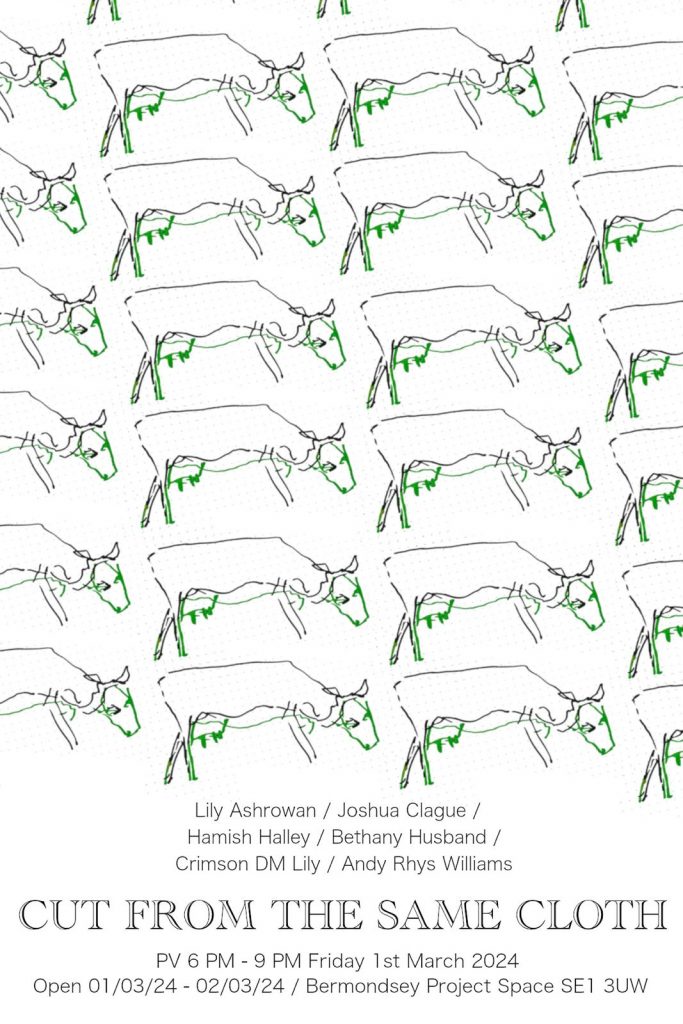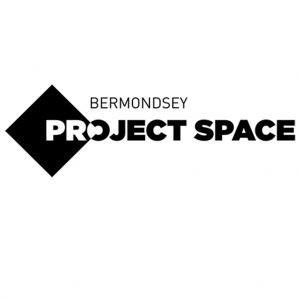1-2 March 2024
Private view : Friday 1 March 2024, 6-9pm
Cut From the Same Cloth is a group exhibition using material mythmaking to excavate personal memory and family history.

How can we reconcile the role of personal memory with history? Personal memory is already so shifting, imbued with the unreliability of individual orientations, hangups, desires, failures, friendships, political stances, old resentments, dreams, inventions and gaps of forgetting. There is something at stake in the transformation of memory into a representation for public display: It enacts the desire for the creation of a collective memory. But the creation of any kind of history hinges upon these personal accounts, old photographs and oral traditions handed down, covered in fingerprints. How might the process of material exploration allow us to acknowledge multiplicities, personal affinities and situated experiences? These are the common questions at stake in Cut From the Same Cloth, as each artist negotiates how personal and family memories negotiate their place in specific cultural histories.
Curated by Lily Ashrowan
Lily Ashrowan (b. 1999) Working with video, photography and text, Ashrowan excavates personal and family histories to think through memory, movement and creating political consciousness. At present she has been working with her mother and her own childhood memories of rural Northern Ireland, to think through how we narrate personal and post-conflict memory, drawing out themes of both generational trauma and shared joy. Lily is currently working towards performance work, which combines video projection with live performed speech. Most recently, her films have been screened at The Royal Scottish Academy Annual Exhibition (2023); Alchemy Film and Moving Image Festival (2022) and With Whom We Mutually Communicate, Copeland Park Gallery (2022).
Joshua Clague (b.2000) Dwelling on personal grief, Clague’s practice reflects on his own process and lived experience of mourning. Articulating both the materiality of loss and the enduring love which remains, encapsulated in the poetic moments that linger thereafter. Amongst these ephemeral remnants of memory, Clague’s practice contemplates the cross-temporal affinities between past and present; finding non-linear connections amongst personally charged materials, such as gay popular music or the scent of lavender, in hopes to find solace in the everyday. His work has been shown at the Bloomberg New Contemporaries 2022 and he is currently undertaking a residency at the Bluecoat Gallery, Liverpool, where his debut solo show ‘And it feels like I just got home” opens in February 2024.
Hamish Halley (b.1999) Halley works primarily with textiles, video, and printmaking and often with foraged materials, such as plant matter, abandoned furniture or raw wool. He investigates these materials, histories, and personal narratives to raise questions about custodianship, inter-species relations, labour, and tradition. Recently this has included naturally dyeing and hand quilting textiles into maps, stuffed with feathers and hay, engaging with labour, agricultural history and his own experience. In an ongoing video work Halley examines his grandparent’s possessions and the renovation of a local museum, allowing him to process material history and challenge his own personal and cultural heritage. Previous exhibitions include: Bloomberg New Contemporaries, Hull and London (2022-23), Creature Comforts, JGM Gallery, London (2022), Make Film History screening at CCA, Glasgow (2022). His video work ‘Nicky Tams’ has been acquired by The Arts Council Collection.
Bethany Husband (b.1998) Bethany’s practice centres around drawing as a mode of reporting and storytelling. She explores patterns of precise lines and experiments with methodological processes of drawing to produce diagrammatic yet fluid pieces. Husband’s work is situated the intersection of medical and artistic knowledges, influenced by familial mythmaking and storytelling. Employing a range of drawing techniques, filmmaking and textiles, she mythologises points of contact that speak to the meeting of the domestic and the clinical and what it means to care. She is concerned with the macabre relationship she has to her father’s work as a surgeon, and the gestures he employs in retelling. Mapping such stories onto the body of the family dog, she considers the notion of animality in her drawings and films. She is currently undertaking an ongoing archival project focused on the life and art of her great, great, great Aunt Mary Beatrice Kerry whose practice was heavily influenced by the impressionist style. Kerry’s most productive era of drawings, letters, diaries and paintings was 1901, while she was governess to the Viscount of Sacavam in Caldas da Rainha, now the Museu da Cerâmica. Husband is working with this museum, as well as her family archive and inherited stories, to piece together a picture of her life.
Crimson DM Lily (b. 1998) Her current research involves how heritage can contribute to identity and reflecting on how ancestry and birthplace contributes to personal identity: why one desires to showcase, or hide, the culture and geography of one’s belonging. She is also concerned with: Capitalism and consequences of its powers; the fashion industry and its psychological impact; the dialectical tensions found in tailoring and how one can treat fabric as an organism when adorning the body. She enjoys the dynamism that comes from collaborating with musicians. Recent collaborations include Welsh speaking, post punk band Adwaith, and London based punk band Thigh High. Her skill set is informed by traditional textile techniques but used in a ‘punk’ manor. Digital collaging also informs her process, using nonchalant photos from her phone and journal sketches/writings. She makes installations, garments, and wall mounted pieces. She encourages viewers to physically interact with the piece to bring life and value to the artwork.
Andy Williams (b.1999). Williams works primarily with mosaic-clad sculpture, studying how human gestures of extraction, distortion and demolition express notions of value. He is interested in the varying identities that are formed around the making, breaking, hoarding, hiding, and digging up of ‘stuff’. Formally, the work tends to appear in varying states of collapse or dissolution with references to industrial process, archaeology and acts of iconoclastic vandalism. Most recently Williams has been exploring these themes in regard to acts of extraction within his own family’s relationship to the material and ephemera from a long-standing coal mining tradition. In addition to delivering a guest lecture as part of The London School of Mosaic’s Artist Talk series and completing a week-long residency at General Practice in Lincoln, he has exhibited work at Safehouse 1, Avalon Cafe and in Pragmata Collective’s Open Fragments online exhibition.
